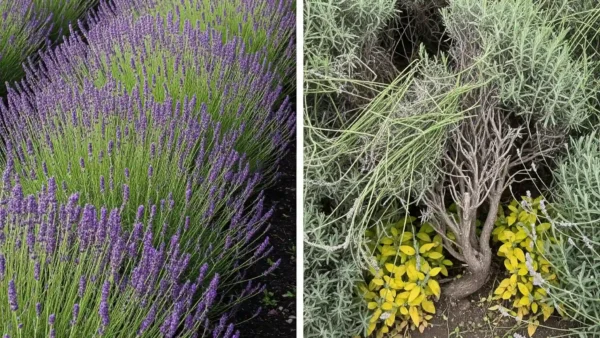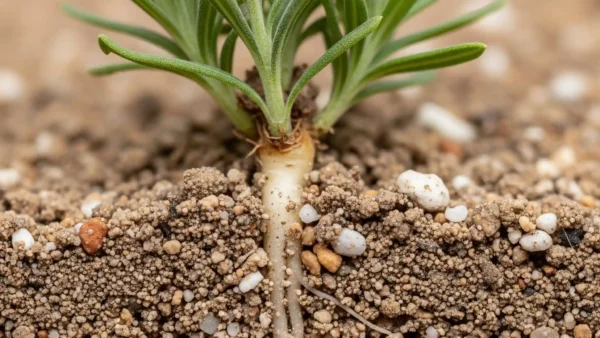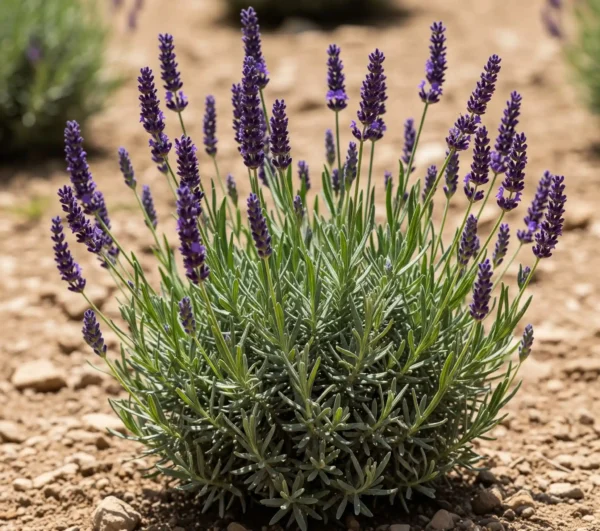A Gardener’s Guide to Seeds vs. Seedlings vs. Cuttings: The Lavender Nursery
One lovely lavender plant on your terrace is inspiring larger dreams. You see a scented hedge running alongside your path, a humming border teeming with bees, or terracotta pots of purple dots decorating your garden scene. The dream is lovely. What then is the next action to bring it to pass?
This forces every grower to choose three somewhat distinct routes to a lavender garden. Does a nursery sell existing plants? You try the age-old miracle of growing them from seed? Alternatively, do you follow the smart path of copying your current favorite?
TL;DR: Your Lavender Propagation Plan
- For Beginners & Guaranteed Success: Buy Seedlings. This is the fastest, most reliable way to get a specific, named variety like ‘Hidcote’ or ‘Phenomenal’. While it’s the most expensive option per plant, your success rate is extremely high.
- For Budget-Friendly Mass Plantings: Use Seeds. If you need dozens of plants for a large hedge or field and have patience, seeds are the most economical choice. Remember the two most important rules:
- Cold Stratification is a MUST: Lavender seeds need a 30-40 day cold, moist period in the refrigerator before planting to break dormancy.
- Light is Required for Germination: Do not cover the seeds with soil; just press them onto the surface.
- For Cloning Your Favorite Plant for Free: Take Cuttings. This is the only way to create an exact genetic copy of a specific hybrid lavender (like ‘Grosso’ or ‘Provence’). Take 4-6 inch “softwood” cuttings (new, green growth) in late spring or early summer for the best results.
Let us first clearly define the ideal use for every technique. Buying healthy seedlings is the gold standard for newcomers looking for a specific designated variety and certain success. For the patient, a budget-conscious gardener in need of dozens of plants for a big undertaking, seeds provide amazing value. Cuttings are also the only real method for people looking for an exact clone of a cherished, maybe costly hybrid plant.
The correct decision is based on whatever approach best fits your particular objective, not on which is “best” generally. This Lavender Planting Guide will empower you to become a confident and competent lavender propagator by dissecting the pros, cons, and exacting method for each path.
All set to choose whether you are a sower, buyer, or cloner? Let’s investigate the three ways one may establish a lavender legacy.
The Sure Thing: Why Startners Should Start with Lavender Seedlings?
There is certainly no guilt in this route of immediate fulfillment! Often the best option is to start with a healthy nursery-grown seedling, particularly if you are just starting your lavender adventure.
- The advantages include: Here there are really noteworthy benefits. Above all, there is great success rate. You are beginning with a known plant that has already emerged from the most fragile phase of existence. Second is the time saved; you can avoid waiting for germination and slow early development over several weeks or months. Above all, purchasing a seedling assures you. Purchasing a plant tagged “Hidcote” or “Phenomenal guarantees that is exactly what you are getting.
- The main and basically only drawback is the expense. Without a question, this is the most costly approach used per plant. Making a lengthy hedge out of nursery seedlings might be a big expensive outlay.
A Guide for Purchasing Healthy Lavender from an Expert
Not every nursery plant is made exactly like another. Look past the depressing discount shelves and develop your ability to identify a champion.
- Look at the foliage; it should be robust with a good, silvery-green or gray-green hue. Steer clear of plants with black, mushy-looking stems close to the soil line or yellowing leaves—this is a classic indication of root rot.
- The most crucial step is to check the roots. Slide the plant gently out of its pot if the store lets you. You want to see a strong network of white, business-minded roots. Put back any dark brown or black mushy roots you find. The plant is “root-bound” if the roots are tightly mass-bound and quite dense, circle the bottom of the pot. You can still buy it, but before planting you will have to gently tease and untangle those roots to help them spread outward into the new soil.
- Search the undersides of leaves and the stems for any evidence of aphids or spittlebugs. Start with a tidy, healthy plant.
Planting starts simple once you have your ideal seedling. This is your opportunity to give it the house it so richly deserves. As your first step toward success, keep in mind to offer it the ideal soil and sunlight.
From Little Seeds, Strong Lavender Growers: An All-Inclusive Handbook
Seeing a plant grow from a little specks of dust into a fragrant, blossoming specimen brings a special and great delight. While difficult, growing lavender from seed is a really fulfilling endeavor.
- The main benefit, though, is cost. Purchasing a package of hundreds of seeds for the cost of one nursery plant will allow you to create a large field or hedge most economically. And, naturally, there is its sheer magic.
- The Cons & Challenges: This road calls for awareness of lavender’s unique demands and patience.
- Lavender seeds are famously sluggish to germinate; occasionally they take a month or more. Furthermore erratic is germination; some seeds sprout weeks after the first ones.
- Many novices overlook this “golden knuckle” tip, the Stratification Secret. A built-in dormancy mechanism in lavender seeds keeps them from sprouting at the incorrect season. You have to fool them into believing they have gone through a winter if you are to break their dormancy. We term this process cold, moist stratification. Easy is it? Fold your seeds into a damp paper towel or toss them with a tablespoon of moist sand. Before you intend to plant, seal the package in a plastic bag and store it in your refrigerator for thirty to forty days. Your germination success rate is much raised by this chilling phase.
- Crucially, the hybrid dilemma is this. Like any Lavandin ‘Provence’ or ‘Grosso’, seeds taken from hybrid lavenders will NOT grow true to the parent plant. Hybrids are a cross between two separate species; their seeds, should they develop any at all, will be a genetically unstable combination, returning to traits of their grandparent plants. The outcomes will be erratic. Only plant seeds from open-pollinated species such as Lavandula angustifolia (English Lavender), if you like consistent, predictable plants.

A Detailed Sowing Guide Step-by-Step
- Prepare your medium. Starting using a sterile seed-starting mix will help to prevent “damping-off,” a fungus that kills young seedlings. Before you sow, moisten the mix.
- After their cooling period, thinly scatter the seeds over the mix’s surface.
- Lavender seeds need light to sprout; they cannot be covered. Keep things buried rather than To guarantee proper touch, softly press them down on the ground’s surface.
- Set the seed tray on a heat mat or in a warm area. Maintaining humidity, cover it with a clear plastic dome. Since the seeds need light, a position beneath grow lights or in a clear window is perfect.
- Water Carefully: Never let the ground get waterlogged; keep it always moist. Daily surface misting is more beneficial than heavy watering.
- Be calm and wait. The first little green shoots may show from two weeks to more than a month. Once they do, take off the plastic dome to increase air movement.

The Way of the Cutting: How to Make a Perfect Clone Right Here for Free
The sweet spot between the economy of seeds and the simplicity of seedlings is this approach. Any gardener should develop this excellent, useful, and fulfilling ability.
- The advantages: First of all, it’s absolutely free. Second, it’s far faster than from seed; a cutting taken in April can bloom tiny by the next year. Above all, a cutting produces exactly the genetic clone of the original plant. This is the only method to faithfully clone a named hybrid cultivar such as “Phenomenal” or “Grosso.”
- The only significant drawback is that you must obtain the cuttings from a healthy, established “mother plant”.
A Methodical Guide on Taking Cuttings
- Timing rules everything. Lavender cuttings are ideal taken late spring or early summer. You want to use “softwood,” the robust, fresh green growth from the current season that hasn’t yet bloomed or turned woody. For roots, this fresh growth has the most energy and cellular action.
- Look for a straight, healthy stem without bloom buds on it. Perfect is a stem between 4 and 6 inches long.
- Prepare the cutting by snipping the stem off the mother plant with a sterile, sharp knife or pruning shears. From the bottom two-thirds of the cutting, gently peel the leaves. The little nodes where the leaves were joined are where the fresh roots will show up.
- Although some cuttings will root without it, dipping the bare end of the stem in rooting hormone powder greatly boosts your success rate by telling the plant cells it is time to produce roots.
- The ideal medium is not rich potting soil, which retains too much moisture and could rot the raw stem. Plant the cutting in a container loaded with a sterile, gritty, soilless medium—perhaps a 50/50 mix of perlite and vermiculite, or even simply coarse sand.
- You have to provide a humid environment to stop the leafty top of the cutting from drying out before it has roots to absorb water. Use a clear plastic bag, propped up with sticks so it doesn’t contact the leaves, or cover the pot with a plastic dome.
- Patience and Testing: Never full sun; place the pot in a warm position with strong, indirect light. You can test for roots four to six weeks later. Give the stem a quite light tug. If you run across resistance, congrats! You have produced a fresh lavender plant really effectively.
Cuttings, Seeds, or Seedlings? An Interpretive Manual for Making Decisions
Which road then best fits you? Allow me to dissect it here.
| Strategy | Expense | Challenge | Time to Bloom | Best For… |
|---|---|---|---|---|
| Seedlings | Highest | Easiest | Immediate | Novices, quickly acquiring a specific variety |
| Seeds | Lowest | Hardest | 1-2 Years | Gardeners on a budget, mass plantings |
| Cuttings | Free | Medium | ~1 Year | Expanding a collection, cloning a favorite hybrid |
- For the new gardener, start with seedlings. You want to enjoy the plant and develop confidence. Guarantee your success this year; next year, from your flourishing plant, try cuttings.
- If you have some patience and require fifty plants to line a driveway, seeds are your solution for the Budget Landscaper. The savings are enormous, and the end effect will be a lovely, somewhat variegated sea of purple.
- If you are in love with the particular performance, color, or aroma of your cherished ‘Grosso’ Lavandin, cutting cuttings is the only method to generate more of that precise plant.
In conclusion
Starting your lavender adventure is a personal choice that reflects your objectives as a grower. There is only the optimal way for your budget, schedule, and goals—not a single “best” one. You are making a great stride whether your search is for the quick satisfaction of a nursery plant, the patient magic of a seed, or the deft multiplication of a cutting.
The three paths are illustrated by this Lavender Planting Guide; now you may boldly start down the road toward a garden bursting with scent.
Often asked questions
Why won’t my lavender seeds sprout?
Two further factors are skipping the cold stratification stage and a lack of light. Lavender seeds need light to sprout, hence they should be forced onto the ground surface rather than buried. Most crucially, before they will consistently “wake up” from their natural hibernation, they must have a chilly, wet spell in the refrigerator for roughly one month.
Why cannot I simply sow a seed from my “Grosso” lavender?
Given ‘Grosso’ is a sterile hybrid, its seeds are usually not viable. Should you discover a fertile hybrid, its seeds would not develop “true to type.” The resultant plants would not look or smell like your “Grosso,” and their genetic mix would be random from their parent plants. A hybrid cannot be cloned except by cuttings.
Can I harvest lavender cuttings in fall?
From the more mature, woody sections of the stem, you can harvest “hardwood” cuttings in the fall; but, they are far slower and more difficult to root than the fragile “softwood” cuttings taken in late spring. Spring and early summer cuttings give a far better likelihood of success for beginners.
Should I harden off my recently planted lavender?
Correct! For any plant produced inside from seed or cuttings, this is a crucial and sometimes overlooked stage. You have to progressively adapt them to outside surroundings. Bring them outside for a few hours each day over a week to increase the daily time before you place them in their ultimate location in the garden. This helps avoid shock from the abrupt variations in wind, sun, and temperature.








